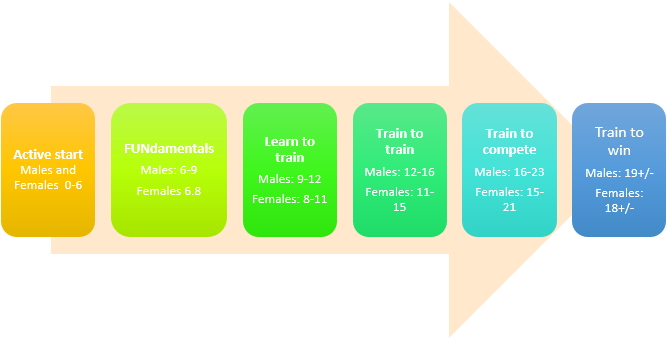The LTAD Model
The LTAD model is a multi-stage training, competition and recovery pathway that guides an individual’s experience in sport and physical activity. The stages in the LTAD pathway provide developmentally appropriate programs for all ages with the aim of increasing participation and optimizing performance (Canada Sport Institute, 2014). Rugby would be classified as a late specialisation sport and so the 6 stage LTAD model is often used when looking at long term planning for rugby (Balyi and Hamilton, 2004). Each of these stages will be discussed in detail in the upcoming sections. This model is illustrated in the figure below (Canada Sport Institute, 2014).

It should be noted that while the LTAD model is a very popular model it is not without its faults, it is theoretical and there are other models for the long term development of players. The faults are discussed further in the Advanced Conditioning modules (Level 2) but one example is that the stages are based on chronological age and as discussed previously, chronological age often does not link with the development and maturation of the player.
All long term development models are theory based and it is very difficult to prove if they actually work. They provide a framework but should not be taken as a golden set of rules that must be followed to the letter. Who is to say that a player cannot progress onto the next stage of the long term development model a little earlier or a little later than stated in the model. Is this going to prevent them from developing as a rugby player? In reality no, and so the LTAD model and all the other models should be used to guide coaches and not restrict their ability to make their own training decisions about players they know very well.
The National Strength and Conditioning Associate (2016) released a position statement on long term athletic development and produced 10 guidelines that any long term physical development plan should consider. They are shown in the figure below (NSCA, 2016). These guidelines, rather than providing a long term development model, provide useful points to adhere to when training physical capacities in youth rugby players.
| No. | Description |
|---|---|
| 1. | Long-term athletic development pathways should accommodate for the highly individualised and non-linear nature of the growth and development of youth. |
| 2. | Youth of all ages, abilities and aspirations should engage in long-term athletic development programs that promote both physical fitness and psychological wellbeing. |
| 3. | All youth should be encouraged to enhance physical fitness from early childhood, with a primary focus on motor skill and muscular strength development. |
| 4. | Long-term athletic development pathways should encourage an early sampling approach for youth that promotes and enhances a broad range of motor skills. |
| 5. | Health and wellbeing of the child should always be the central tenet of longterm athletic development programs. |
| 6. | Youth should participate in physical conditioning that helps reduce the risk of injury to ensure their on-going participation in long-term athletic development programs. |
| 7. | Long-term athletic development programs should provide all youth with a range of training modes to enhance both health- and skill-related components of fitness. |
| 8. | Practitioners should use relevant monitoring and assessment tools as part of a long-term athletic development strategy. |
| 9. | Practitioners working with youth should systematically progress and individualize training programs for successful long-term athletic development. |
| 10. | Qualified professionals and sound pedagogical approaches are fundamental to the success of long-term athletic development programs. |